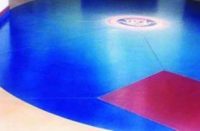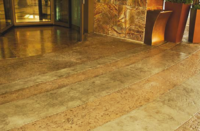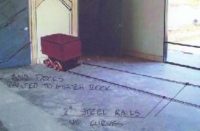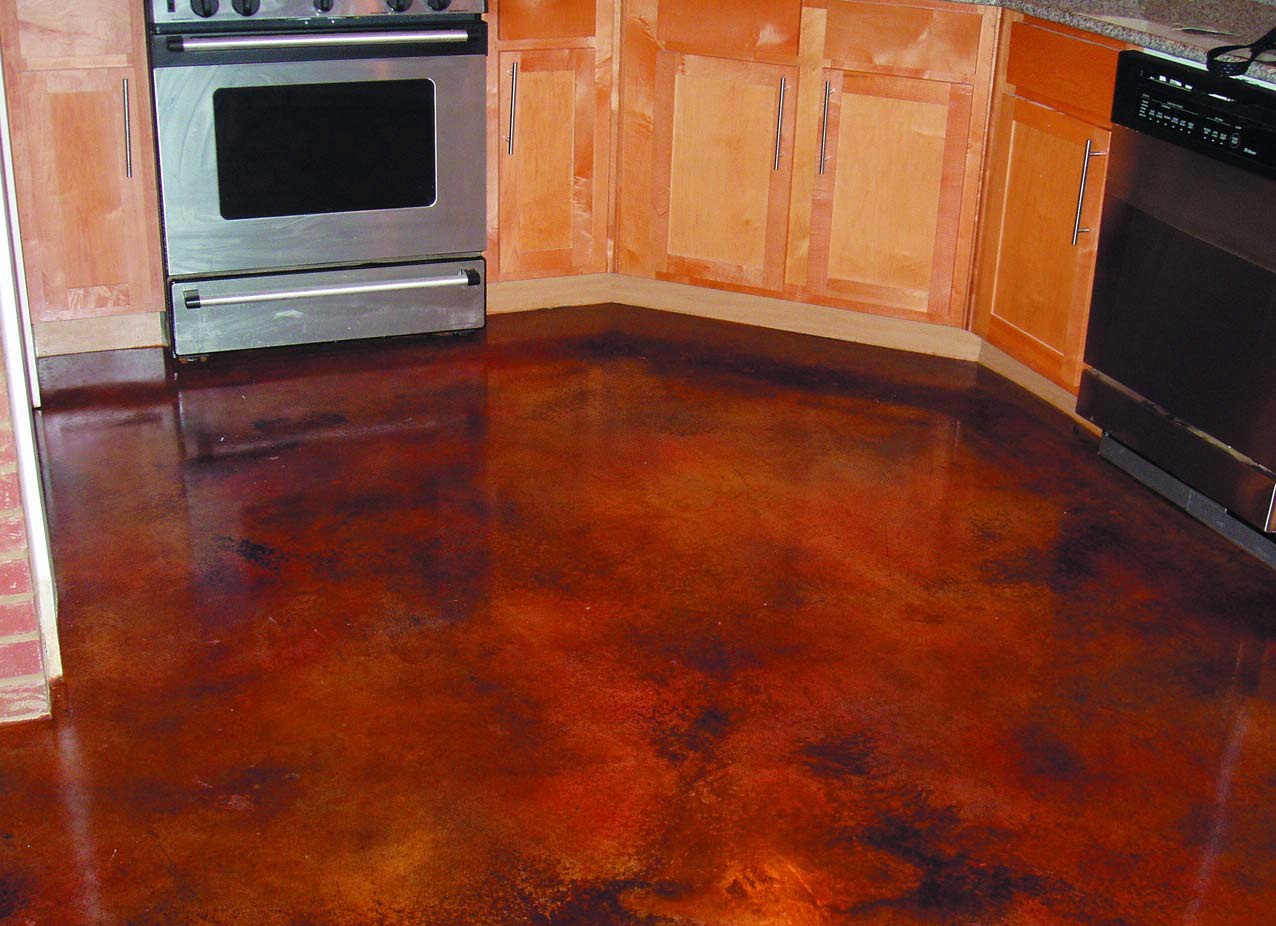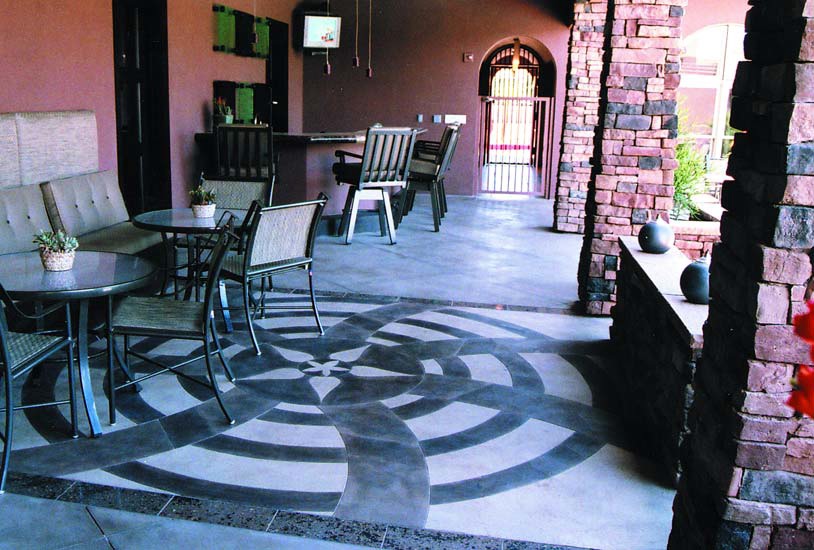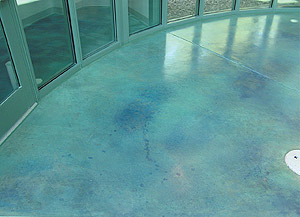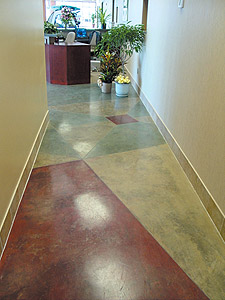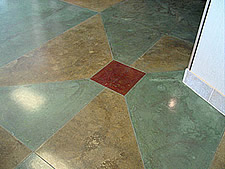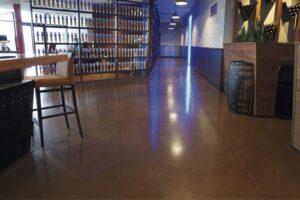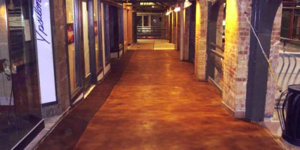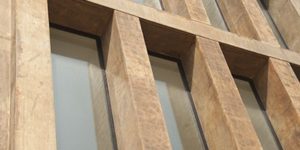From subtle marbling to psychedelic tie-dyeing, some of the most artistic effects in decorative concrete are achieved by putting one color of acid stain on top of another.
There are many ways to go about layering acid stains, but a common approach is to cover the entire floor with a diluted color, then spot-stain sections with less diluted or undiluted colors, often using faux techniques such as ragging or sponging.
This approach reflects the rule of thumb that says lighter colors first, darker colors on top. If you do it the other way around, chances are the darker color will swallow up the lighter one.
There are exceptions, though. Some blue-green acid stains, for instance, stand out nicely on even the darkest underlying stain.
Bob Harris of the Decorative Concrete Institute in Georgia has gotten stunning results by applying green acid stain on top of black acid stain. “You get some very, very nice marbling and veining, and a lot of contrasting and layering of color,” he says.
Dana Boyer of Concretizen in Arizona has had similar success in violating the light-then-dark rule of thumb. “It’s best to start with your light layers and build from there, but there have been times when I’ve taken a dark brown, then come in with a full strength turquoise and thrown it on there,” she says. “The turquoise is not going to be as bright, but it gives me some good results.”
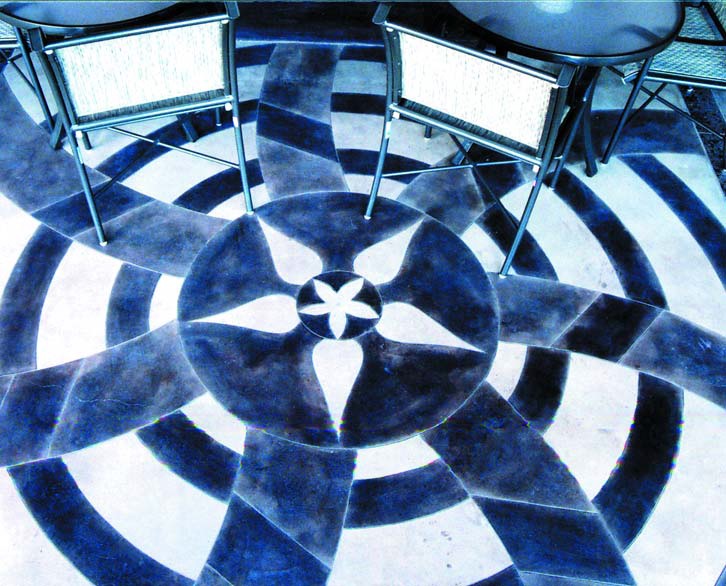
Wet or dry layering
Whether or not you wait for one layer of color to dry before applying the next depends on the sort of transition between colors you want.
In the wet-on-wet approach — in which there’s no wait — colors tend to mingle and roll together. They may blend in strange and beautiful ways. Or they may look horrible. Results can be highly unpredictable, and there’s no substitute for doing a sample on an unobtrusive section of the substrate.
“I have 13 years of experience with acid staining, and I still don’t know what I’m going to get with wet-on-wet every time,” says Wes Vollmer of Alternative Finishes in Texas. “But that’s what’s fascinating to me. It’s like you’re like a big kid coloring.”
Vollmer once used every crayon in the box for an acid-staining job involving a floor at a bed-and-breakfast. He started by covering the entire floor with a light gold stain, then darkened spots here and there with a thin mist of black. Once the black dried, six men in his crew mounted pump sprayers on their backs, each filled with a different color, and set off one behind the other across the floor, randomly applying their colors. They held their nozzles upside down and sprayed upward, layering colors in thin mists.
“It wasn’t the clean, crisp look that I like, but it did look good and the customer liked it,” he says. “The deal with wet-on-wet is you have to know what the customer wants, because you’re going to get results that are a little out there.” In the wet-on-dry approach, an underlying layer of stain is given time to go through its reaction cycle before a subsequent layer is added. Typically the wait ranges from five hours to overnight. Wet-on-dry layering gives you a sharper, cleaner transition between layers, as well as more predictable results.
Bob Harris offers this tip for softening the transition between wet-on-dry colors: Apply water to areas of the base coat that you want to retain, then spray the next layer into the dry spots, just overlapping the edges of the wet areas. “The water softens the hard edge, defusing the transition very softly and very nicely,” Harris says.
Dilution
The more an acid stain is diluted, the softer the color will be and the more layers you can build on top of it. Dilution rates start at 1:1 and generally peak somewhere at around 30:1. Darker colors are especially tolerant of high dilutions.
Many concrete artisans like starting with a color wash — a highly diluted stain — to establish a pastel-like base upon which to build. Washes are particularly useful for toning down the stark white that’s popular in many of today’s microtoppings.
Nice layering effects can be achieved with multiple applications of a single color of stain, diluted at different rates. For example, a base layer of amber covering an entire floor might be diluted 10:1. Eighty percent of the floor might then be stained with amber diluted at 5:1. Finally, details might be added using a 2:1 dilution.
Harris has a tip for diluting on the fly: Wet down some sections of the cementitious surface but not others, then spray an acid stain evenly across both wet and dry areas. The stain will essentially dilute itself in the wet areas but not the dry. “And you get some very nice layering effects,” Harris says.
Many contractors use nothing but water to dilute stain, but manufacturers discourage the practice and offer stain extenders — essentially acid stain without the color — for dilution purposes.
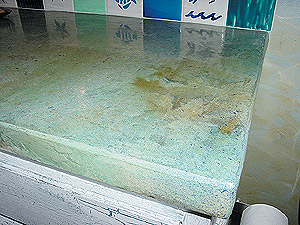 “I would be very wary about diluting with water,” say Chris Sullivan, technical director for concrete product manufacturer QC Construction. “Stains are composed of mineral salts, acid and water. You start adding too much water and you’ll find that the mineral salts will fall out of solution and no longer be soluble. And you also won’t get the reaction and the penetration into the concrete.”
“I would be very wary about diluting with water,” say Chris Sullivan, technical director for concrete product manufacturer QC Construction. “Stains are composed of mineral salts, acid and water. You start adding too much water and you’ll find that the mineral salts will fall out of solution and no longer be soluble. And you also won’t get the reaction and the penetration into the concrete.”
Residues and resists
Some brands of acid stain are known to leave heavy residues, especially those at the darker end of the spectrum. Residue will impede the reaction of subsequent layers of stain. If residue is heavy enough it might have to be washed off before the next layer of color is applied.
Or you might use it for creative effect.
“You can create textures if you lightly damp mop over the dried residue, rewetting it and moving some of it around,” Boyer says. “Then when you come in and apply another color, you’ll be able to see the textures and depth.”
The entire gamut of faux techniques can be used in layering colors.
George Lacker of GLC3 Concrete in Florida has used everything from sawdust to corncobs to get interesting layered effects. One technique he likes is using a sea sponge to apply a mottled layer of sealer on top of a light color. Once the sealer dries, he applies a darker color of stain. That too gets mottled with sealer. Then he finishes things off with an even darker stain. The second and third layers of color don’t react with the sealer, which allows what’s beneath to show through.
“There’s all kinds of possibilities,” Lacker says. “There’s unbelievable amounts of things you can do.”
How much is too much?
There are limits to how many layers of color can be built up on top of one another. One limit is the availability of free lime, which acid stains need to react with. Each layer of acid stain uses up some of the free lime in the cementitious surface. Once all lime is gone, so is the ability of the cementitious surface to take further acid stain.
Another limit is aesthetic. Too many colors stacked on top of each other will cancel each other out. Sullivan refers to this as “The Banana Split Effect.” “In a banana split, you start with vanilla, strawberry and chocolate,” he says. “If you let them all melt together, the brown in the chocolate overpowers everything else, and you get one brownish, gooey mess. So I would say be careful — if you get to the point where you try to blend too many colors, it all just becomes a mess.”
Yet another limit is what a client is willing to pay for. Many clients are perfectly content with the variation, depth and price of a single layer of acid stain. If they’re willing to pay for extra layers, it’s critical for the contractor to work closely with them to ensure they understand what they’re getting into. “In this business, success depends 100 percent on matching clients’ expectations,” says Doug Carlton of Carlton Concrete in California. “You have to really screen your clients and make sure they have a really open mind as to what the multiple-layer-buildup floor will look like.”
The more a contractor practices and experiments with layering color, the better the final results of a layered stain job are likely to be.
“It all really boils down to the artist, the person, their talent, and their ability to understand the materials and make things different and unique,” says Boyer. “Once the contractor gets the basics of staining, then stain is stain. It becomes a matter of practicing, and having and wanting that pride, to move forward.”
